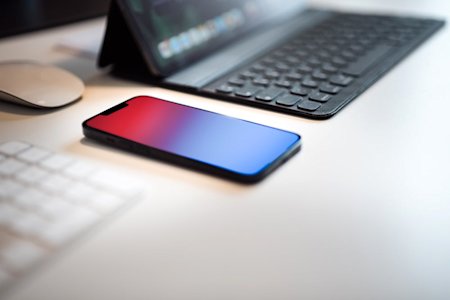Mobile devices like iPhones and Android phones are more powerful than ever, capable of running complex apps, managing remote work, and handling business communication on the go. But when it comes time to present something, troubleshoot an issue, or walk someone through an app, you may find yourself asking: how do I screen share my iPhone or Android device?
Whether you're joining a meeting, delivering a demo, or providing IT support, screen sharing from your phone can be incredibly useful. While native options like AirPlay offer some basic capabilities, they often fall short in professional environments where performance, security, and cross-platform compatibility matter.
This guide’ll explore how to screen share on iPhones and Android devices using Splashtop’s secure remote access and screen mirroring tools. You’ll learn how to set up screen sharing, which methods to use for different scenarios, and how Splashtop makes it easy to share your mobile screen reliably, whether you're in the same room or miles apart.
Benefits of Sharing a Phone Screen
Even if you don’t use your phone as your primary work device, there are many situations where phone screen sharing is important. These are just a few situations where being able to screen share on an iPhone or Android can be essential:
Meetings: Screen sharing is an important meeting tool, whether you’re in a virtual or in-person meeting. If you have to share files, videos, or anything else from your phone, knowing how to screen share on iPhone and Android devices can make your meetings far more efficient.
Presentations: Similarly, if you have presentations stored on your phone, screen sharing makes it easy to broadcast them across devices or onto a large projector. This is excellent for conferences, lectures, seminars, and more.
IT support: Screen sharing is a powerful tool for IT support. When users have technical issues with their phones, being able to screen share iPhone and Android devices allows the agent to see exactly what the issue is and guide the user through troubleshooting and repairs.
Remote work: Screen sharing is excellent for remote work and collaboration, as it allows employees to communicate and work together on shared projects from a single screen.
Choosing the Right Mobile Screen Sharing Tool
While many chat and messaging apps will include some form of screen sharing, that doesn’t mean just any will suffice. iPhone and Android screen sharing in a business environment requires specialized tools designed to provide a clear and seamless screen sharing experience.
When looking at screen sharing solutions, consider your business needs and what will help make your teams as efficient and productive as possible. This includes:
Functionality: Do you need an app that can only share static screens, or do you need more powerful functionality? For many businesses, screen sharing alone isn’t enough, and they need features like annotations, audio sharing, or remote access to iPhone and Android devices.
Device compatibility: Not all screen sharing apps work with the same devices. If you want phone screen sharing, you’ll need to find a platform that lets you screen share on iPhone, Android, and any other mobile device.
Ease of use: Overly complex solutions can cost more productivity than they save. You need a solution that’s user-friendly and efficient, while still providing the tools and functionality your teams need.
Security: Not every app with phone screen sharing is secure, so choosing the wrong one can lead to data leaks, compromised accounts, and other cyber threats. Make sure you find a solution with a robust set of cybersecurity features so you can share your screens without worrying about who else might be watching.
Cost: The prices for screen sharing solutions can vary significantly, but in most cases, you get what you pay for. You need to make sure you’re getting a solution that provides all the features, tools, speed, and video quality you need while still remaining at a reasonable price.
How to Set Up Your Android and iPhone for Screen Sharing
If you want efficient and effective screen sharing, it helps to be prepared. These are a few steps you can take to set up your phone for the best screen sharing experience:
Check your network: A strong network connection is important for high-definition and seamless screen sharing. Otherwise, the feed may suffer from poor image quality and lag.
Use the latest software: An outdated operating system or app could lead to connectivity issues or security vulnerabilities. If it’s been a while since your last update, make sure you’re using the latest versions of your phone and app.
Log in where necessary: Certain screen sharing tools require you to be logged in to the same account. For instance, if you want to screen share from an iPhone on AirPlay or similar software, you’ll need both devices to be logged in to the same Apple account.
Enable permissions: Apps, by default, typically aren��’t allowed to share anything from your phone. Check your settings to ensure you’ve given the necessary permissions to enable screen sharing.
How to Screen Share iPhone or Android Remotely with Splashtop Remote Support
When it comes to remote support, Splashtop Remote Support provides a fast, secure, and reliable way to view a mobile device’s screen in real time. Whether you're assisting a customer, helping a colleague, or diagnosing a technical issue, Splashtop SOS lets you see exactly what’s happening on their iPhone or Android device, no guessing required.
Steps to Share Your Screen with Splashtop SOS
For the mobile user (on iPhone or Android):
Download and install the Splashtop SOS app from the App Store (iOS) or Google Play Store (Android).
Open the SOS app and allow any necessary permissions (such as screen recording or capture).
Generate a 9-digit session code displayed on the device screen.
For the technician or viewer:
Open the Splashtop Business app on your Mac or Windows computer.
Enter the 9-digit code provided by the mobile user.
Once the session starts, you’ll be able to view the live screen feed from the iPhone or Android device.
Important Notes:
iPhone screen sharing is view-only. Due to iOS restrictions, remote control is not allowed.
On iOS devices, the user must manually tap “Start Broadcast” from the Control Center to begin screen sharing.
On Android, some device models allow for remote control if proper accessibility permissions are granted.
Use Cases for Splashtop SOS Mobile Screen Sharing
Remote IT support for troubleshooting mobile apps, settings, or connectivity issues
App walkthroughs and onboarding for employees or customers
Visual validation during testing or development of mobile applications
Real-time guidance for mobile-based workflows or complex setups
Splashtop Remote Support ensures secure, encrypted connections and is trusted by IT professionals worldwide to streamline support across all device types.
How to Mirror Your Phone Screen Locally with Mirroring360
If you want to share your iPhone or Android screen with other devices on the same local network, like a classroom display, meeting room monitor, or group of laptops, Mirroring360 is the ideal solution. It allows you to wirelessly broadcast your mobile screen to a compatible computer, without needing extra cables or an Apple TV.
How to Mirror Your iPhone Screen (via AirPlay)
Mirroring360 works seamlessly with Apple’s native AirPlay protocol, making it simple to cast your iPhone screen to any computer running Mirroring360 Receiver.
Steps:
Make sure your iPhone and the receiving computer are connected to the same Wi-Fi network.
On the receiving computer, launch the Mirroring360 application.
On your iPhone, open the Control Center and tap Screen Mirroring (or AirPlay).
Select the computer running Mirroring360 from the list.
Your iPhone screen will now be mirrored wirelessly to the computer.
Ideal for presentations, education, and live demonstrations where remote access isn’t necessary but clear screen display is.
How to Mirror Your Android Screen
Mirroring360 supports Android screen sharing through the Mirroring360 Sender app, available on the Google Play Store. This lets Android users share their screen with a Mirroring360-enabled receiver using a QR code or Mirroring ID.
Steps:
Install the Mirroring360 Sender app on your Android phone.
Launch the app and scan the QR code or enter the Mirroring ID displayed on the receiving computer.
Your Android screen will begin mirroring to the selected device on the same network.
Scale It Up with Mirroring360 Pro
If you need to share your mobile screen with a larger group, Mirroring360 Pro allows you to broadcast to up to 40 devices at once via a shareable web link. This is perfect for:
Classrooms and training rooms
Conference sessions and lectures
Group demos without specialized hardware
Get Started With a Free Trial of Splashtop: The Best Solution for Your Mobile Screen Sharing Needs
If you want a powerful, reliable solution with high-quality screen sharing, Splashtop has everything you need. Splashtop’s remote access and support make it easy to share your iPhone or Android screen with any other device for remote support and work, while Mirroring360 provides fast and seamless screen sharing with local devices.
Whether you need to share your screen for meetings, lectures, IT support, or any of the other myriad ways, you can try Splashtop for yourself today with a free trial:





